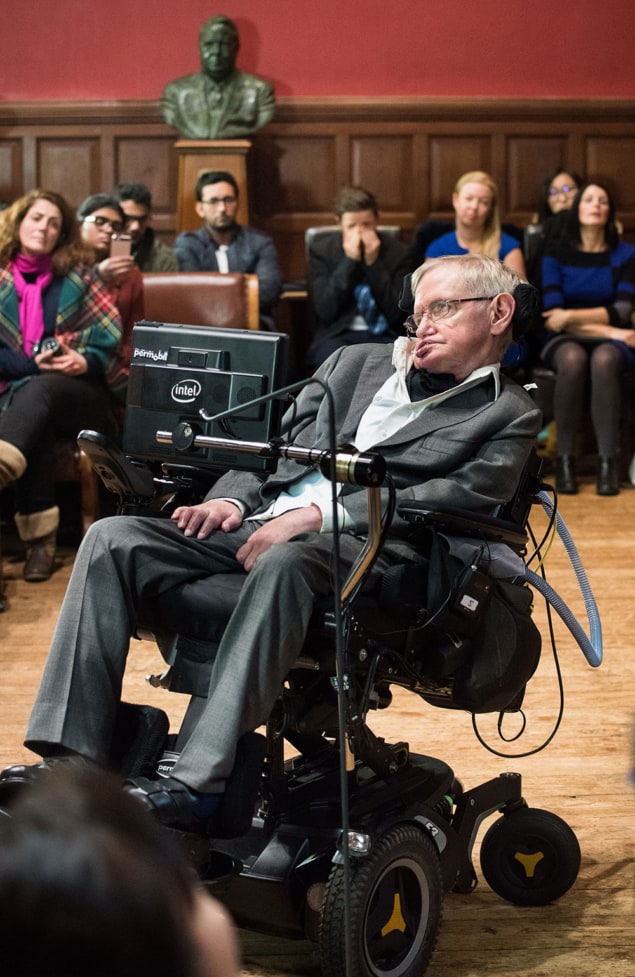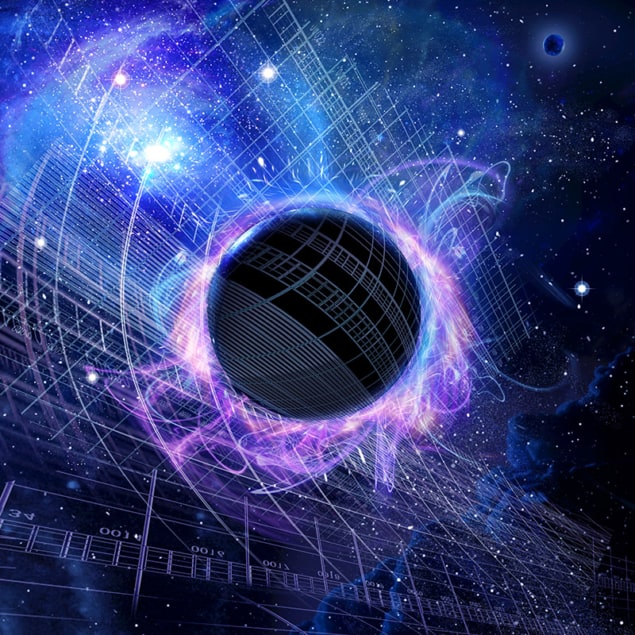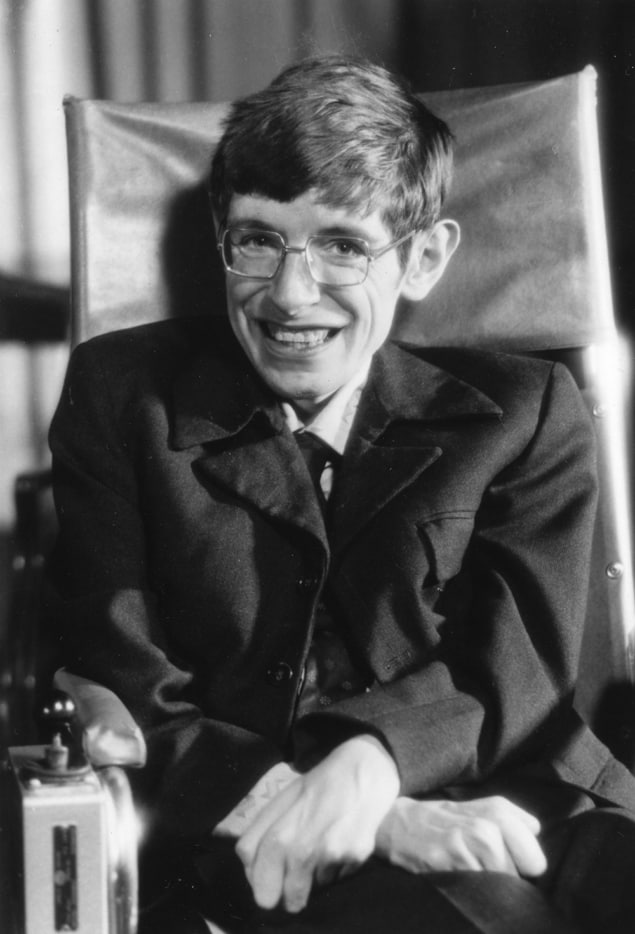Congratulations to Seth Lloyd, whose article “Stephen Hawking’s scientific legacy“ has been picked as one of Physics World‘s five favourite features of 2018. The article is taken from the May 2018 issue of Physics World.
The late Stephen Hawking is an icon of modern physics. As well as inspiring generations of scientists, his contributions have changed our understanding of the universe. Seth Lloyd looks back over Hawking’s key scientific achievements, from gravitational singularities to quantum cosmology
The time: spring 1984. The place: a lecture hall at the University of Cambridge.
Students crowd the seats. In front of the blackboard a stage rises a foot above the floor of the hall. On the stage a man in a wheelchair speaks in a murmur to a graduate student. The student has red tinted glasses and is wearing a soft, cream-coloured jacket. The man: murmur, murmur, murmur. The student: “Professor Hawking says, ‘This lecture is about the edge of the universe.’ ” Murmur, murmur, murmur. “The edge of the universe is very far away.” Murmur, murmur. “Nonetheless, we can still picture it as follows…” The student draws a diagram on the board. The lecture continues, Hawking murmuring, and the student translating. The topic is complex, but the flow is clear. Hawking is an exceptional lecturer, and because everything is said twice, once in a murmur and once in translation, there is extra time to think.
The occasion is Stephen Hawking’s seminar on quantum gravity, and he is talking about his latest work. The audience is rapt and Hawking is excited. He is impatient for the student to finish each translation, and while the student is speaking and writing on the board, Hawking fidgets. Confined by a degenerative motor-neurone disease, he can only move his fingers, which he is using to shift his wheelchair side to side – dzzt, dzzt – as the student speaks – dzzt, dzzt. Each time he moves side to side, however, he also moves imperceptibly backwards. Half an hour into the lecture a huge crash breaks the spell. Hawking’s wheelchair topples off the edge of the stage and is lying on its back on the ground. Hawking’s feet dangle in the air and students jump up to right the chair. He is crumpled at an odd angle, shaking violently. Is he dying? No – he’s laughing. Murmur, murmur, murmur. “Professor Hawking says, ‘Fell off the edge of the universe.’ ”
Hawking led a full and complete life, despite his illness, and his scientific work inspired generations of students to study problems of gravity and quantum mechanics. In the weeks since his death on 14 March, many of his colleagues have written of his remarkable life and work. This article will touch upon a few of his primary scientific accomplishments – in particular, his work on classical gravity and singularities, his famous results on black-hole thermodynamics and Hawking radiation, and his efforts to quantize gravity.
Out of the singularity
As a young man, Hawking worked on general relativity, investigating the problem of how black holes form. His mastery of geometrical methods allowed him to prove a set of remarkable theorems about the circumstances under which swirling clouds of matter undergo gravitational collapse, giving rise to gravitational singularities. Working together with Roger Penrose, who had been investigating similar problems, Hawking produced a remarkable paper in 1970 entitled “The singularities of gravitational collapse and cosmology” (Proc. Roy. Soc. Lond. A 314 529).

In this work, he and Penrose proved that “reasonable” space–times would exhibit both singularities in the future (either the final singularity in a closed universe, or singularities present in black holes) and singularities in the past (the Big Bang). Here, “reasonable” means that the space–time does not possess causal irregularities – such as closed time-like curves – and matter obeys a strong energy condition, so that the presence of matter focuses neighbouring geodesics (the shortest lines between points on a curved surface) towards each other.
Taken together, the Penrose–Hawking singularity theorems provide strong evidence for the necessary formation of black holes in our universe. It is a prediction that has been confirmed both by observational evidence of galactic X-ray sources such as Cygnus X-1, and by the recent and spectacular findings from the Laser Interferometer Gravitational-Wave Observatory (LIGO), which has detected the gravitational waves emitted by colliding black holes.
Hawking’s next major work was his most famous. His singularity theorems implied that the area of a black hole’s event horizon increases when more matter and energy is added to the hole, and should never decrease. Consequently, Hawking and colleagues noted that the area of the horizon was analogous to entropy in the second law of thermodynamics: according to which entropy does not decrease, and tends to increase. Building on Hawking’s ideas, Jacob Bekenstein conjectured that the area of the event horizon was in fact equal to the entropy of the black hole, up to a multiplicative constant.
But now there is a problem. Thermodynamic systems with entropy S(E) as a function of energy E must also possess a temperature, defined by 1/kBT = ∂S/∂E. But what is the temperature of a black hole? After all, it is black and, at least classically, no radiation can escape from it.
Out of the black hole
In 1974 Hawking solved the problem of black-hole temperature in spectacular fashion. By applying methods of quantum field theory on curved space–time to black-hole geometry, Hawking was able to show that black holes behave like black bodies, emitting thermal radiation with a temperature ħκ/2πkB (where ħ is Planck’s constant divided by 2π and κ is the surface gravity of the hole), corresponding to a black-hole entropy equal to one quarter of the area of the horizon, measured in Planck units. Hawking’s basic conception of the problem was simple and brilliant.
General relativity is about the reconciliation of different perceptions of the universe. Special relativity reconciles the perceptions of observers moving at different velocities, but all perceiving the speed of light to be the same. General relativity reconciles the perceptions of different observers who choose to assign different coordinate systems to events in a curved space–time. Once quantum mechanics is thrown into the mix, a remarkable feature arises: inertial observers and accelerated observers have an entirely different perception of the vacuum state – the state with no particles. The vacuum, no-particle state for an inertial observer is perceived by an accelerated observer as containing a thermal mix of particles.

In quantum field theory, the vacuum is not empty – it bubbles with virtual particle–antiparticle pairs. An inertial observer sees those virtual pairs come into existence and then go away again before they can be detected. By contrast, an accelerated observer’s particle detector will detect a thermal mixture of particles – the accelerated detector effectively supplies the energy and momentum needed to create real particles out of virtual particles.
Einstein’s equivalence principle states that acceleration supplied by, for example, a rocket, can’t be distinguished from the acceleration supplied by a gravitational field. Consequently, gravitational fields can create particles. In an elegant argument based on quantum field theory in a black-hole space–time, Hawking was able to show that the gravitational field of the black hole creates a thermal mixture of particles emanating from the black hole’s horizon. In the vicinity of the horizon, virtual particle–antiparticle pairs with entangled energies ±E are “promoted” into real particle–antiparticle pairs of outgoing particles with energy E paired with infalling antiparticles with energy –E. Since the energy of the matter falling into the black hole is negative, the black hole’s mass decreases. The black hole radiates.
Hawking’s discovery that black holes were not actually black stunned the community of physicists. His calculations were confirmed by a variety of alternative approaches, which showed that Hawking radiation was a ubiquitous feature of space–times with horizons, including de Sitter space, and space–time as viewed by an accelerated observer.
The result also spurred interest in the theory of quantum entanglement. Hawking radiation consists of an entangled state of matter, in which outgoing particles with energy +E are entangled with infalling particles with energy –E. The entropy of the Hawking radiation can then be identified with the entanglement entropy of the black hole, where the number of bits of entanglement is proportional to the area of the event horizon.
Hawking radiation is regarded by physicists as the one truly reliable result that we actually possess about quantum mechanics and gravity. Many other results have followed it, notably work on supersymmetric fields of quantum gravity, and the anti-de Sitter space/conformal field theory correspondence (AdS/CFT) – a remarkable connection between the behaviour of gravitational fields in a space–time and the quantum fields on the space–time’s boundary – as well as work to derive general relativity from area laws. However, it seems safe to say that Hawking radiation is the one result on quantum mechanics and gravity that is accepted by the entire community of physicists working on the subject.
Many open questions about Hawking radiation remain. Does the radiation contain the information that went into the black hole as it formed, but in some scrambled form? For decades, Hawking said no – there is apparently no way for the information within the hole to get out, at least under the ordinary laws of quantum mechanics on curved space–time. If the underlying laws of quantum mechanics are information-preserving, as suggested, for example, by the AdS/CFT correspondence, then black-hole evaporation is itself an information-preserving process.

Almost certain escape from a black hole
More recently, however, Hawking stated that he believed that information would actually escape from an evaporating black hole, thereby conceding a bet made with John Preskill on the subject. He went on to declare that his statement that information did not escape from a black hole was his “biggest mistake”. In the absence of a universally accepted, self-consistent quantum theory of gravity, or of empirical evidence for the information-preserving nature of black-hole evaporation, however, the question of how or whether information escapes from black holes must remain open.
Quantum cosmology
In the 1980s Hawking went on to do seminal work on quantum cosmology: his work with Jim Hartle and with others on the quantum theory of universes without boundary represents a conceptually compelling method for approaching the perennially difficult problems of quantum mechanics and the history of the universe as a whole. From this approach Hawking and collaborators were able to obtain useful and suggestive results on quantum cosmology, and cosmological inflation.
The no-boundary approach led to what Hawking had previously called his “biggest mistake”, until he decided that declaring that information didn’t escape from a black hole was worse. Upon using the technique to derive a wave function for the universe that was symmetric in time, Hawking declared that a universe that expanded and then contracted would undergo exact time reversal during the contraction phase. Raymond LaFlamme and Don Page were quickly able to show to Hawking that nothing of the sort need occur. The wave function Hawking had obtained was a quantum superposition of two cosmologies, one starting from a state of low or zero entropy and expanding while entropy increased, and the second being the same cosmology as the first but with time t replaced by –t. If the arrow of time within a universe is to be assigned by the inhabitants, however, then the inhabitants of both universes would likely vote to assign the direction of increasing time in the direction of increasing entropy, so that the second cosmology would be experienced by its inhabitants as being the same as the first, rather than as going backwards in time.
Dancing to the music of time

After the publication of his book A Brief History of Time in 1988, and the attendant well-deserved fame, Hawking had less time to devote solely to physics, but he continued to come up with novel and provocative ideas for his entire career. His illness forced him to take things slowly, thinking things out with great thoroughness before putting them forth. But that slow approach served him well.
The scene: a dinner in Mazagon, Spain, at a workshop on the physics of time asymmetry, organized by Jonathan Halliwell, Juan Perez-Mercader and Wojciech Zurek. Hawking is sitting with a bunch of students and postdocs, very slowly eating a very large steak that has been cut up into very small pieces. Everyone is discussing the just-ended conference excursion, which was to a flamenco club in Sevilla. People were asking Stephen how he had ended up dancing with the most accomplished flamenco dancer there. Then the conversation moved on to physics, quantum gravity and so on. Hawking was working away at the keys on his voice synthesizer, and, five minutes later, with a twinkle in his eye, informed us, “I choose my wheelchairs for their…danceability.”




